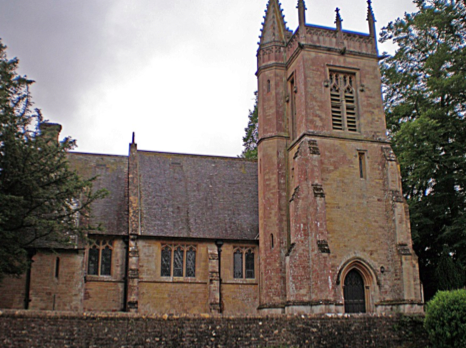The Hartham Park estate chapel will be open as part of the Heritage Open Days Event, which is being organised by the Corsham Civic Society by the kindness of the Trustees of the Chapel. It will be open to be public on the afternoon of the 9th September 2012 between 2 and 4.30pm.
It is rather a remarkable building, quite as large as many parish churches, built in 1862 as the private chapel for the Hartham Park estate. Hartham is part of the parish of Corsham, but not of the manor of Corsham, and has a rather separate history. Its history is intertwined between two houses, Hartham House and Hartham Park (two different houses, but often confused). By 1862 Hartham House had been pulled down and the Hartham Park estate was being expensively aggrandised by members of the Poynder family.
Little has been written about the Poynders. They originated as lime-burners in south London in the late eighteenth century. They became normously rich in the early nineteenth century as builders of parts of the rapidly expanding metropolis, first in south London and the City and then in Holloway, in north London. When Thomas Poynder died in 1837, probate was valued at £370,000, one of the biggest fortunes of the first half of the nineteenth century (multiply by say 10,000, and recall that death duties or income tax had yet to be invented).

Hartham Chapel
In 1813 Thomas Poynder had bought the village of Hilmarton, Wiltshire as his country estate. By 1850 his grandson, Thomas Henry Allen Poynder, found this estate not quite grand enough, so he leased the Hartham Park estate from the Methuen family and then he bought it in 1855. He set about the expensive building works by encasing the 1790 James Wyatt house in Victorian extensions, building new stables and including his THAP initials with his distinctive monogram. These were prominently placed on various cottages and farms in Hartham, Pickwick and Biddestone.
To cap all this estate improvement, he had the Chapel built in 1862, on the avenue to the house made from a route of the earlier London to Bath turnpike. The architect commissioned for this work was the distinguished Victorian architect Philip Hardwick (1792-1870), who may have designed the earlier extensions to the house. The house itself has no dates on it, but the later stables have dated rainwater heads with THAP and the monogram together with the date 1858. T.H.A. Poynder (1814-73) had studied at Oxford and was a barrister. The family money came from trade some three or four generations previously. Those in line were all called Thomas, though I have yet to work them all out. He was a Victorian gentleman who had his priorities right – first the house, then the stables and then the chapel.
Philip Hardwick, the architect, remains best known for his design of the Euston Arch, famously wantonly- destroyed in 1962 in the interests of ‘modernism’. He also designed the warehouses in the London docks, and other London buildings such as Goldsmiths’ Hall. By 1860 he was reducing his workload and handing over to his son, Philip Charles Hardwick (1822-92), who could be the real architect of the chapel.
The chapel is very elegantly designed. It was very well built, with no expense spared and is a remarkable relic of a prosperous estate of the 1860s, with stone-quarrying income. Nicholas Keyworth, the former Artistic Director of the Pound Arts Centre, which from time to time has organised concerts at the chapel, tells me that the acoustics are very good. The organ is most interesting.
The only changes since 1862 are the Nicholson memorial wall plaques (the Nicholsons bought the estate in 1920 from the Poynders). T.H.A. Poynder, despite all his evident estate-building efforts, had no children, and his heir in 1873 was his brother, W.H. Poynder, who also had no children. This amounted to estate building, with no dynastic planning. The heir in 1880 was the teenage son of their sister Sarah, who had died giving birth to her son, and who in 1884 inherited his father’s brother’s baronetcy, becoming Sir John Dickson Poynder.
The teenage millionaire aristocrat did not feel it necessary to remain a student at Oxford. He continued to expand the Hartham estate, putting his JDP initials (no monogram) on many new buildings in Corsham and Biddestone, expanding the shooting, fishing, golfing, cricket and tennis. Thus creating the estate a young High Sheriff of Wiltshire and MP for Chippenham should have, entertaining fellow politicians and even royalty.
There is no sign of John Dickson Poynder at the Chapel, however. When he was raised to peerage in 1910 he took the title Lord Islington and rejected Hartham. He went off to govern New Zealand and later to become a junior minister, but he never came back to Hartham. He is buried with his Poynder ancestors, not in the chapel at Hartham, but in the church at Hilmarton, where deep layers of leaves have to be kicked off their graves to see the inscriptions.
The Nicholsons, once famous for their gin, bought Hartham Park when it was sold up after the first world war, and more or less survived the second. For a time it was the Bath and Portland Stone Company’s headquarters. Now it has had a remarkable revival as a successful ‘business centre’, with a huge car-park, agreeable common rooms, and many men and women keenly looking at computer screens.
Dr Negley Harte
